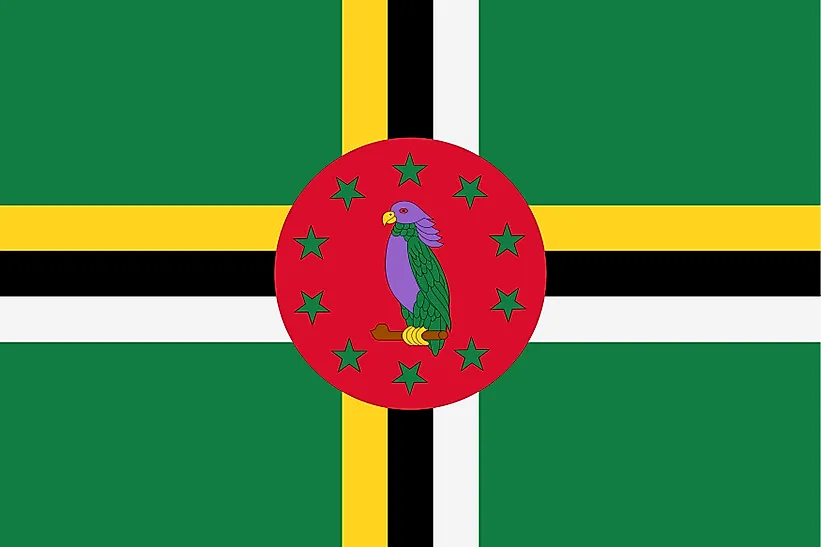
ドミニカ
| 大陸 | 米州 |
| 資本金 | ロゾー |
| 人口 | 73,757 |
| GDP | $812.00百万ドル |
| 一人当たりGDP | $11,400 |
| ダイヤルコード | +1-767 |
| ISOコード(2文字) | DM |
| ISOコード(3文字) | DMA |
ドミニカについて
カリブ海の魅惑的な国、ドミニカへようこそ!ドミニカは、その類まれな自然の美しさと環境保護への取り組みで有名です。わずか751平方キロメートルのこの火山島は、カリブ海と大西洋に挟まれた緑豊かな宝石のような島です。約72,000人が暮らすドミニカは、手つかずの大自然、豊かな文化遺産、持続可能な開発が融合したユニークな島です。近隣諸国の多くとは異なり、この英連邦国家はマスツーリズムよりも生態系保全を優先する道を意図的に選び、「カリブ海のネイチャー・アイル(自然の島)」という当然の称号を得ている。霧に覆われた山々から湧き出る温泉まで、先住民カリナゴのコミュニティから活気あるクレオール文化まで、ドミニカは21世紀になっても手つかずの自然が残る本物のカリブ海を体験させてくれます。
地理的特徴と自然の美しさ
ドミニカの地形は火山芸術の傑作であり、カリブ海で最もドラマチックな風景が見られる。島の背骨は一連の山脈で構成され、モルヌ・ディアブロティンは最高地点で1,447メートルに達する。これらの山々は湿気を含んだ大西洋の風を取り込み、島の約60%を覆う緑豊かな熱帯雨林環境を作り出し、並外れた生物多様性を育んでいる。
島の景観のいたるところに火山の起源が見られ、なかでもユネスコの世界遺産に登録されているモーン・トロワ・ピトン国立公園は壮観だ。この保護地域には、世界で2番目に大きい熱湖である沸騰湖をはじめとする驚くべき地質学的特徴があり、沸点に近い温度で灰青色の水が泡を立てて蒸発している。その近くにある荒涼の谷は、蒸気を噴出する噴気孔、色とりどりの鉱床、小さな間欠泉など、別世界のような風景が広がり、島の地下で今も活動している強力な力を物語っている。
ドミニカの水文学の豊かさも同様に印象的で、地元の人々が誇らしげに語るように、この島には365本の川がある。これらの自然のままの水路は、山がちな地形を流れ落ち、息をのむような美しさの滝を無数に作り出している。トラファルガー滝は、地元で「母」と「父」と呼ばれる一対の滝で、この自然の素晴らしさを体現しています。エメラルド・プールは、穏やかな滝の下にある自然の洞窟で、静かな水泳体験を提供しています。
島の海岸線は、典型的なカリブ海の絵葉書のイメージとは対照的だ。白い砂浜が延々と続くのではなく、ドミニカにはドラマチックな崖や人里離れた入り江、黒や金色の火山砂のビーチがあります。この特徴的な海岸線は、島の海洋環境の保全に役立っており、生き生きとしたサンゴ礁、海底温泉、多様な海洋生物を惹きつける深いドロップオフなどがあります。特にドミニカの西海岸沖は、マッコウクジラが一年中生息している数少ない場所として有名で、ホエールウォッチングの絶好の機会となっています。
文化遺産と伝統
ドミニカの文化は、先住民、アフリカ人、ヨーロッパ人、クレオール人の影響が魅力的に融合したもので、島の孤立性と歴史的回復力の両方によって形成された独特のアイデンティティを生み出している。この文化遺産は、言語、音楽、ダンス、料理、そして過去とのつながりを保ちながら進化し続ける伝統的な慣習を通して表現されている。
カリナゴ族はかつてカリブ族として知られ、東カリブ海に残る先コロンブス時代の最後の民族である。1903年に設立されたカリナゴ・テリトリーは、島の東海岸に約3,700エーカーの敷地を有し、先住民の伝統が実践され保存され続ける故郷となっている。カリナゴの職人たちは、何世代にもわたって受け継がれてきた技術を使って、地元の材料から複雑なバスケットやカヌーなどを作る技術で有名だ。
プランテーション時代の遺産であるドミニカのアフリカの伝統は、島の文化表現に大きな影響を与えている。伝統的な音楽には、アコーディオン、タンバリン、ブーム・ブーム(竹製の楽器)、トライアングルを使ったアンサンブルのジン・ピンや、アフリカに明確なルーツを持つドラム主体の音楽とダンスのスタイルのベレなどがある。これらの伝統的な形式は、ドミニカの伝統的な要素と現代的なカリブ海のサウンドを融合させたブイヨンのような現代的なジャンルと共存している。
この島で毎年行われる祝祭は、文化の多様性と創造性を示すものだ。カーニバル(地元では「リアル・マス」または「マス・ドムニク」と呼ばれる)では、カリプソ競技、路上ジャンプアップ、ほつれた縄の衣装を着た「センセイ」ダンサーなどの伝統的なキャラクターが登場する。毎年10月に開催されるワールド・クレオール・ミュージック・フェスティバルは、カリブ海屈指の音楽イベントとなり、地域内外から演奏家や観光客が集まる。
ドミニカ料理は、島の農業の恵みと文化の影響を反映している。国民食のヤマドリは、実は大きなカエル(現在は保護されており、めったに食べられない)で、伝統的にクレオールソースで調理されている。より一般的な日常食には、ダシーン、ヤムイモ、パンノキのような澱粉質の野菜があり、地元で獲れた魚と一緒に出されることが多い。島の肥沃な土壌は豊富なトロピカルフルーツを生み、その多くはフレッシュジュースや伝統的なラム酒に使われている。
歴史の旅
ドミニカの歴史は、先住民の回復力、植民地争奪、自決の探求という説得力のある物語を紡いでいる。考古学的証拠によれば、この島には紀元前3100年頃にオルソイド人が住み始め、その後アラワク人の入植者が続き、最後にカリナゴ人(カリブ人)がこの島を「Waitukubuli」と呼んだ。
クリストファー・コロンブスは、2度目の航海中の1493年11月3日(日)にこの島を発見し、発見日にちなんでこの島を「ディエス・ドミニカ」(ラテン語で「日曜日」)と名付けた。ヨーロッパ人の主張にもかかわらず、ドミニカの険しい地形と激しいカリナゴの抵抗は、2世紀近くも効果的な植民地化を妨げ、ヨーロッパ人によって植民地化された最後のカリブ海諸島のひとつとなった。
この島は18世紀を通じてフランスとイギリスの帝国的野心の戦場となり、1763年にパリ条約によって最終的にイギリスに割譲されるまで、何度も支配者が変わった。イギリスの植民地化によってコーヒーと木材産業がもたらされ、奴隷にされたアフリカ人が働く砂糖プランテーションが続いた。しかし、ドミニカの山がちな地形は、カリブ海の平坦な島々に比べてプランテーション農業の採算性を低下させた。
1834年に奴隷制が廃止された後、ドミニカは小規模農民の社会として発展し、かつてのプランテーションは小規模な所有地に分割された。1967年にイギリス連合国となり、1978年11月3日に完全な独立を果たした。
独立後のドミニカは、自然災害、経済的変遷、政治的進化などの困難を乗り越えてきた。1979年のハリケーン・デービッドと2017年のハリケーン・マリアは壊滅的な被害をもたらしたが、ドミニカの人々と島の自然システムの両方が驚異的な回復力を持つことも実証した。このような試練を乗り越えて、ドミニカは環境保全と持続可能な開発へのコミットメントを維持し、カリブ海諸国の中でも際立った道を切り開いてきた。
現代の経済状況
今日のドミニカは、伝統的な農業生産とエコツーリズム、サービス、持続可能な開発への革新的なアプローチとのバランスをとりながら、多角的な経済を発展させてきた。ドミニカは意図的にマスツーリズムを避け、自然の美しさと文化の信憑性を評価する観光客の誘致に力を入れている。
農業は依然として重要な経済部門だが、その焦点は時代とともに変化してきた。バナナは歴史的に主要な輸出作物であったが、貿易自由化や自然災害などの課題に直面してきた。これに対応するため、ドミニカの農家は有機栽培、作物の多様化、付加価値の高い加工へとますますシフトしている。島の火山性土壌は、風味豊かなコーヒー、ココア、トロピカルフルーツを生産し、きれいな海は小規模漁業を支えている。
観光産業は、ドミニカの自然資産や文化遺産を重視した独特の路線で発展してきた。ドミニカは、伝統的なビーチ・ツーリストではなく、ハイカー、ダイバー、ウェルネスを求める人、自然愛好家を惹きつけている。カリブ海初の長距離ハイキングコースであるワイトクブリ・ナショナル・トレイル(Waitukubuli National Trail)は、島の全長にわたって14の区間があり、多様な生態系やコミュニティが紹介されている。同様に、ダイビングスポットや温泉、ホエールウォッチングは、自然と有意義に触れ合いたい観光客に魅力的だ。
ドミニカは、その小さな国内市場の限界を認識し、経済開発への革新的なアプローチを開発しました。1993年に設立された投資による市民権プログラムでは、資格のある投資家は国家開発プロジェクトに多大な貢献をする代わりにドミニカの市民権を得ることができます。このプログラムは、インフラ整備、公共住宅、地熱エネルギー資源の開発などに資金を提供している。
2017年のハリケーン・マリアの被害を受けて、ドミニカは世界初の気候変動に強い国になることを約束した。この野心的な目標は、再生可能エネルギー、強靭なインフラ、持続可能な建築手法に重点を置いた復興努力と将来の開発計画の両方を形作っている。ドミニカは地熱資源の開発を進めており、エネルギーの自給自足だけでなく、近隣の島々へのクリーンエネルギーの輸出国になる可能性もある。
国際関係とグローバルポジション
小島嶼開発途上国であるドミニカは、環境擁護、地域協力、持続可能な開発パートナーシップを中心に、積極的な国際的プレゼンスを維持している。ドミニカの外交政策は、小島嶼国が直面する特別な課題、特に脆弱なカリブ海諸国に存亡の危機をもたらす気候変動に重点を置いている。
ドミニカはカリブ共同体(CARICOM)、東カリブ諸国連合(OECS)、カリブ諸国連合(ACS)、英連邦のメンバーである。これらの組織を通じて、カリブ海諸国は地域統合の取り組み、集団外交、教育、医療、安全保障などの分野における共同サービスに参加している。
ドミニカは、イギリス、アメリカ、カナダなどの伝統的なパートナーや、カリブ海の近隣諸国と特に強い関係を築いてきた。ここ数十年、ドミニカは中国、ベネズエラ、キューバ、EUとも外交・経済関係を拡大し、開発の機会を最大限に生かす現実的なアプローチを追求している。
ドミニカは、国際的な気候変動交渉において主導的な役割を果たし、より野心的な世界的行動と、脆弱な国々における適応と回復力への支援強化を提唱してきた。ハリケーン・マリアの後、ルーズベルト・スケリット首相は国連総会で力強い演説を行い、「エデンは壊れている」と宣言し、気候変動対策への国際的な取り組み強化を呼びかけた。
ドミニカは、環境保護への取り組みにより、さまざまな国際的保護イニシアティブのパートナーとしても位置づけられている。ドミニカの保護区、持続可能な漁業管理、再生可能エネルギー開発は、世界的な持続可能性の目標に合致しており、国際機関や環境財団からの支援を集めている。
ご存知でしたか?
- ドミニカにはモーン・トロワ・ピトン国立公園があり、東カリブ海初のユネスコ世界遺産に登録されている。
- この島は、人口1人当たりの百寿者(100歳以上の高齢者)の数が世界で最も多い島の1つであり、その理由は、住民の健康的なライフスタイル、清潔な環境、自然な食生活にある。
- ドミニカの沸騰湖は世界で2番目に大きいホットレイクで、湖の端の温度は約92℃を保っているが、中心部は温度が高すぎて危険である。
- この島は、映画『パイレーツ・オブ・カリビアン』シリーズのいくつかのシーンで主要な撮影場所として使用され、その手つかずの風景は、手つかずのカリブ海の舞台を象徴している。
結論
ドミニカは、自然遺産と文化的アイデンティティを尊重する開発路線を選択することの力を示す証しである。この驚くべき島は、険しい地形、広いビーチの欠如、自然災害への脆弱性といった潜在的な制約を、カリブ海地域で際立った強みに変えてきた。湧き出る火山の特徴から霧深い山の熱帯雨林、先住民カリナゴのコミュニティから活気あふれるクレオール語のフェスティバルまで、ドミニカは今日の世界ではますます珍しくなっている本物の体験を提供しています。この「自然の島」は、気候変動への回復力と持続可能な開発へのアプローチを開拓し続けており、小さな島国が経済的進歩と環境スチュワードシップを両立させる独自の道をどのように切り開くことができるのか、刺激的なモデルを示している。世界的な環境問題の時代にあって、自然の宝を守りながら強靭な社会を築こうとするドミニカの取り組みは、ドミニカ国外にも広がる貴重な教訓を与えてくれる。





